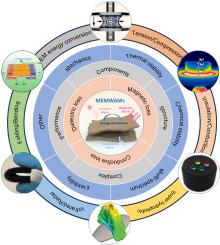多功能电磁波吸波材料:从构件结构设计到智能集成的研究进展
IF 11.6
2区 材料科学
Q1 CHEMISTRY, PHYSICAL
引用次数: 0
摘要
随着5G/6G通信、智能隐身技术和柔性电子技术的快速发展,电磁波吸收材料正从单一性能优化向多功能集成发展。传统吸波材料的单功能特性已被证明不足以满足复杂应用场景的要求。这些场景涉及复杂的电磁环境和恶劣的操作条件,因此越来越需要多功能能力。此外,多功能集成吸波材料的研究相对分散,缺乏从原子尺度到宏观结构的系统调控框架。本文从“功能集成维度”出发,以“材料构件优化、跨尺度结构设计、多功能集成”三位一体为基础,系统组织构建了一个分析框架。在此基础上,系统探讨了高力学性能、热稳定性、化学稳定性、多光谱相容性、柔性生物相容性和智能响应六大类多功能电磁波吸收材料(MEMWAMs)的设计原理和性能协同机制。本文旨在总结现有的memwam设计原则,并展望下一代memwam“按需设计”的发展路径,其特点是协同介电/磁损耗、增强的环境鲁棒性和集成的智能响应。本文章由计算机程序翻译,如有差异,请以英文原文为准。

Multifunctional electromagnetic wave absorbing materials: research progress from component structural design to intelligent integration
Amid the rapid development of 5G/6G communications, intelligent stealth technology, and flexible electronics, electromagnetic wave absorbing materials (EMWAMs) are advancing from the optimization of a single performance aspect toward multifunctional integration. The monofunctional nature of conventional absorbing materials has proven inadequate to satisfy the requirements of complex application scenarios. These scenarios involve intricate electromagnetic environments and harsh operational conditions, where multifunctional capabilities are increasingly necessary. Moreover, the research on multifunctional integrated microwave absorbing materials is relatively scattered, lacking a systematic regulatory framework from the atomic scale to the macroscopic structure. Starting from the “functional integration dimension,” this review systematically organizes and constructs an analytical framework based on the trinity of “material component optimization, cross-scale structural design, and multifunctional integration.” On this basis, this review systematically explores the design principles and performance synergy mechanisms of six major categories of multifunctional electromagnetic wave absorbing materials (MEMWAMs): high mechanical properties, thermal stability, chemical stability, multispectral compatibility, flexible biocompatibility, and intelligent response. The review aims to summarize existing design principles and envision the development path of “on-demand design” for the next generation of MEMWAMs, characterized by synergistic dielectric/magnetic loss, enhanced environmental robustness, and integrated intelligent response.
求助全文
通过发布文献求助,成功后即可免费获取论文全文。
去求助
来源期刊

Carbon
工程技术-材料科学:综合
CiteScore
20.80
自引率
7.30%
发文量
0
审稿时长
23 days
期刊介绍:
The journal Carbon is an international multidisciplinary forum for communicating scientific advances in the field of carbon materials. It reports new findings related to the formation, structure, properties, behaviors, and technological applications of carbons. Carbons are a broad class of ordered or disordered solid phases composed primarily of elemental carbon, including but not limited to carbon black, carbon fibers and filaments, carbon nanotubes, diamond and diamond-like carbon, fullerenes, glassy carbon, graphite, graphene, graphene-oxide, porous carbons, pyrolytic carbon, and other sp2 and non-sp2 hybridized carbon systems. Carbon is the companion title to the open access journal Carbon Trends. Relevant application areas for carbon materials include biology and medicine, catalysis, electronic, optoelectronic, spintronic, high-frequency, and photonic devices, energy storage and conversion systems, environmental applications and water treatment, smart materials and systems, and structural and thermal applications.
 求助内容:
求助内容: 应助结果提醒方式:
应助结果提醒方式:


